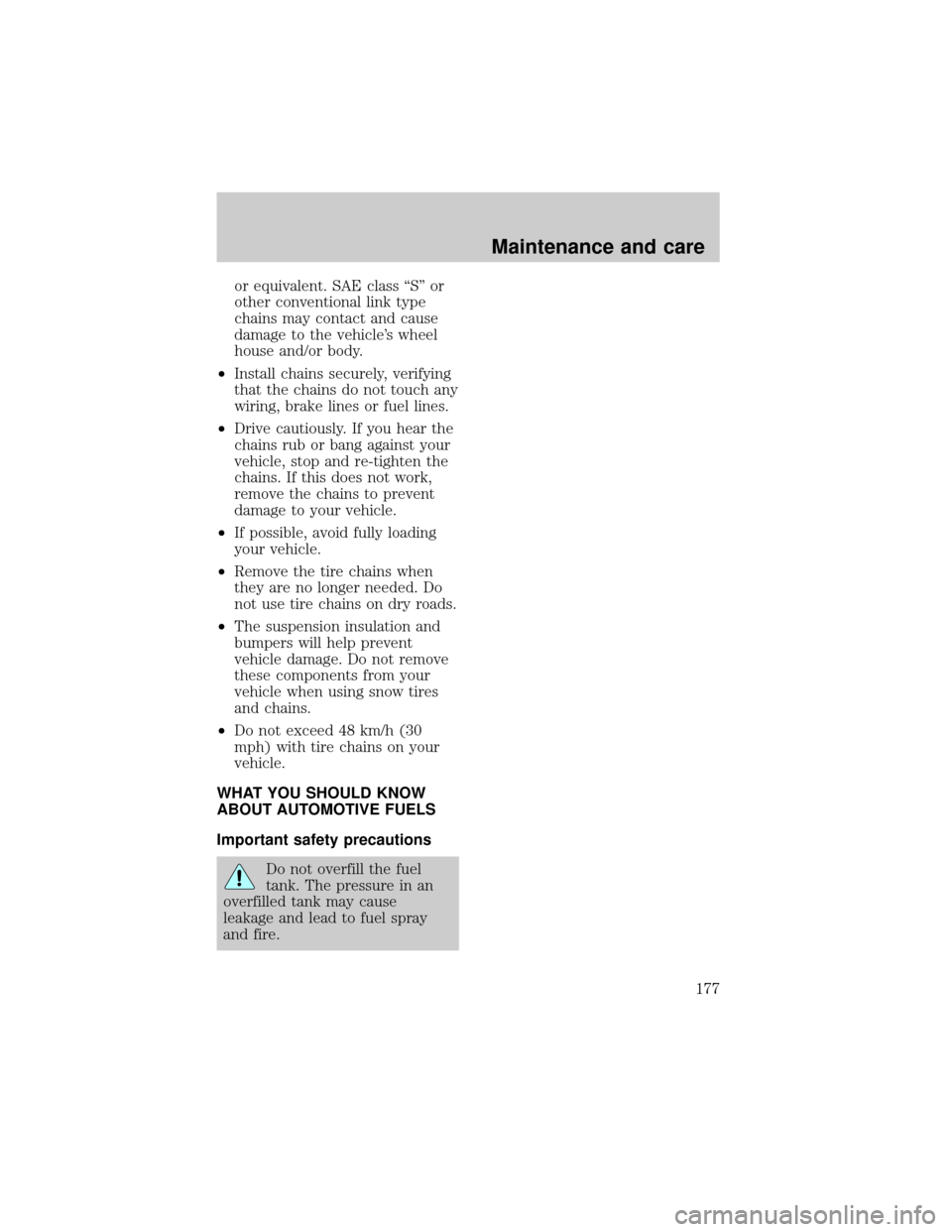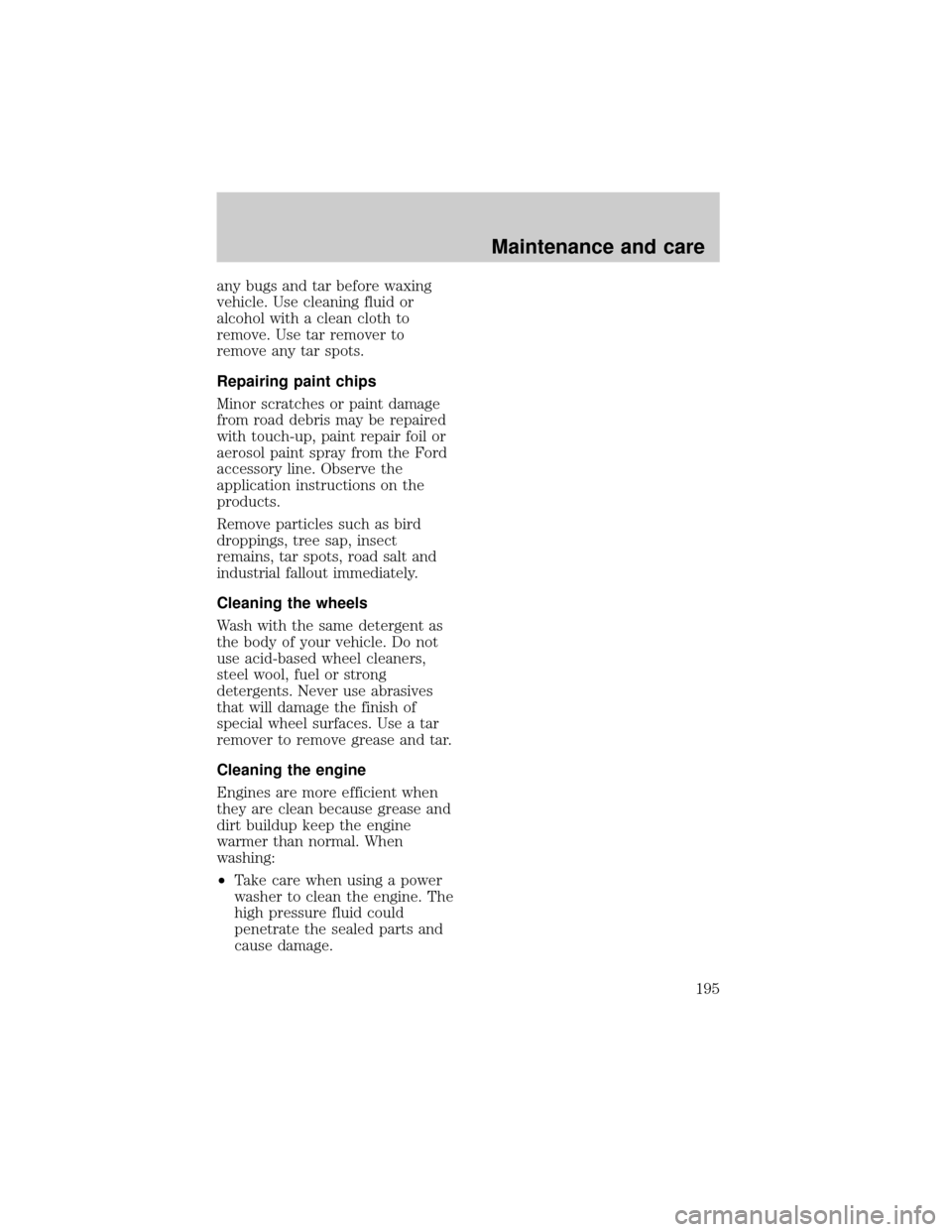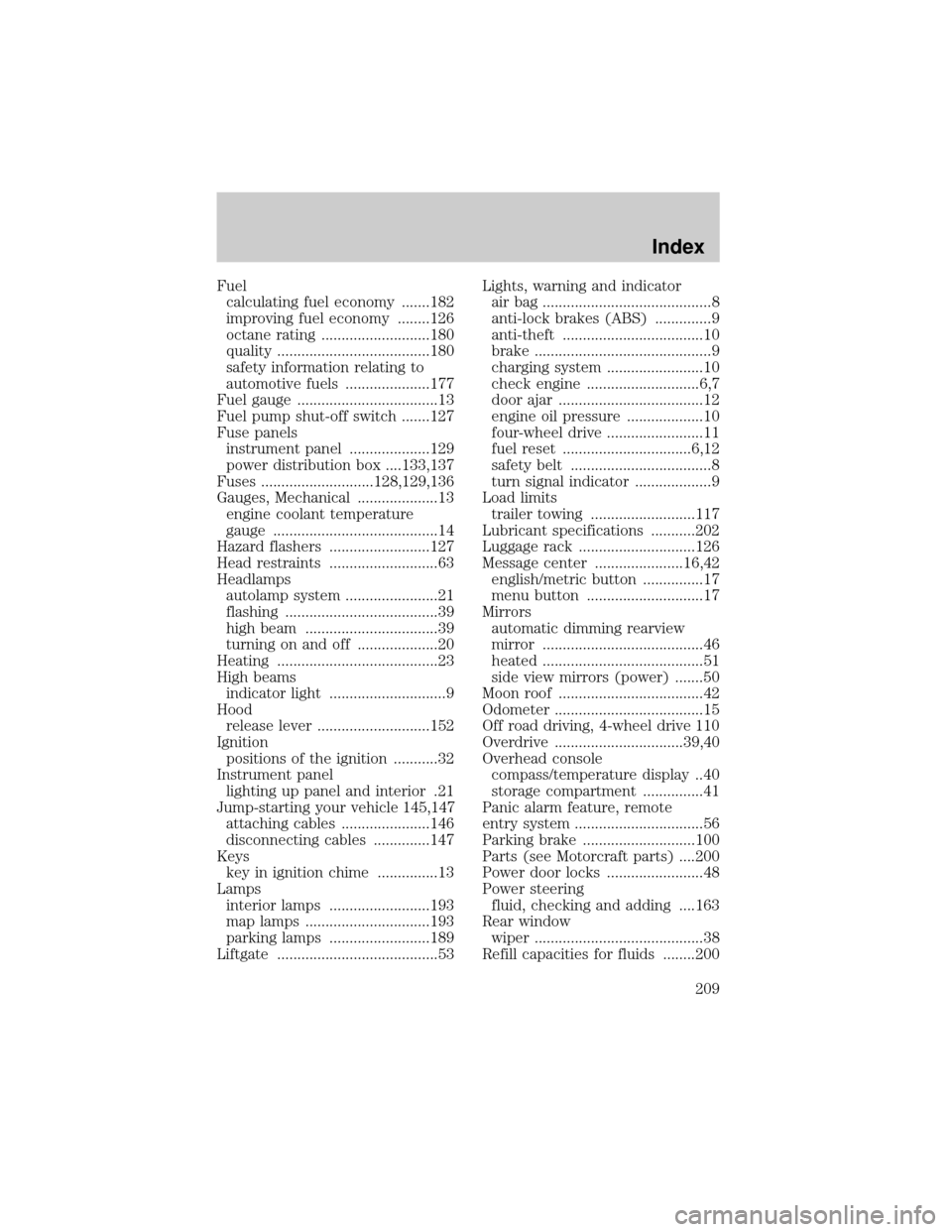Page 177 of 216

or equivalent. SAE class ªSº or
other conventional link type
chains may contact and cause
damage to the vehicle's wheel
house and/or body.
²Install chains securely, verifying
that the chains do not touch any
wiring, brake lines or fuel lines.
²Drive cautiously. If you hear the
chains rub or bang against your
vehicle, stop and re-tighten the
chains. If this does not work,
remove the chains to prevent
damage to your vehicle.
²If possible, avoid fully loading
your vehicle.
²Remove the tire chains when
they are no longer needed. Do
not use tire chains on dry roads.
²The suspension insulation and
bumpers will help prevent
vehicle damage. Do not remove
these components from your
vehicle when using snow tires
and chains.
²Do not exceed 48 km/h (30
mph) with tire chains on your
vehicle.
WHAT YOU SHOULD KNOW
ABOUT AUTOMOTIVE FUELS
Important safety precautions
Do not overfill the fuel
tank. The pressure in an
overfilled tank may cause
leakage and lead to fuel spray
and fire.
Maintenance and care
177
Page 178 of 216
If you do not use the
proper fuel cap, the
pressure in the fuel tank can
damage the fuel system or cause
it to work improperly in a
collision.
The fuel system may be
under pressure. If the fuel
cap is venting vapor or if you
hear a hissing sound, wait until it
stops before completely
removing the cap.
Automotive fuels can
cause serious injury or
death if misused or mishandled.
Observe the following guidelines
when handling automotive fuel:
²Extinguish all smoking materials
and any open flames before
fueling your vehicle.
²Always turn off the vehicle
before fueling.
²Automotive fuels can be harmful
or fatal if swallowed. If fuel is
swallowed, call a physician
immediately, even if no
symptoms are immediately
apparent. The toxic effects of
fuel may not be visible for
hours.
²Fuels can also be harmful if
absorbed through the skin. If
fuel is splashed on the skin,
Maintenance and care
178
Page 195 of 216

any bugs and tar before waxing
vehicle. Use cleaning fluid or
alcohol with a clean cloth to
remove. Use tar remover to
remove any tar spots.
Repairing paint chips
Minor scratches or paint damage
from road debris may be repaired
with touch-up, paint repair foil or
aerosol paint spray from the Ford
accessory line. Observe the
application instructions on the
products.
Remove particles such as bird
droppings, tree sap, insect
remains, tar spots, road salt and
industrial fallout immediately.
Cleaning the wheels
Wash with the same detergent as
the body of your vehicle. Do not
use acid-based wheel cleaners,
steel wool, fuel or strong
detergents. Never use abrasives
that will damage the finish of
special wheel surfaces. Use a tar
remover to remove grease and tar.
Cleaning the engine
Engines are more efficient when
they are clean because grease and
dirt buildup keep the engine
warmer than normal. When
washing:
²Take care when using a power
washer to clean the engine. The
high pressure fluid could
penetrate the sealed parts and
cause damage.
Maintenance and care
195
Page 209 of 216

Fuel
calculating fuel economy .......182
improving fuel economy ........126
octane rating ...........................180
quality ......................................180
safety information relating to
automotive fuels .....................177
Fuel gauge ...................................13
Fuel pump shut-off switch .......127
Fuse panels
instrument panel ....................129
power distribution box ....133,137
Fuses ............................128,129,136
Gauges, Mechanical ....................13
engine coolant temperature
gauge .........................................14
Hazard flashers .........................127
Head restraints ...........................63
Headlamps
autolamp system .......................21
flashing ......................................39
high beam .................................39
turning on and off ....................20
Heating ........................................23
High beams
indicator light .............................9
Hood
release lever ............................152
Ignition
positions of the ignition ...........32
Instrument panel
lighting up panel and interior .21
Jump-starting your vehicle 145,147
attaching cables ......................146
disconnecting cables ..............147
Keys
key in ignition chime ...............13
Lamps
interior lamps .........................193
map lamps ...............................193
parking lamps .........................189
Liftgate ........................................53Lights, warning and indicator
air bag ..........................................8
anti-lock brakes (ABS) ..............9
anti-theft ...................................10
brake ............................................9
charging system ........................10
check engine ............................6,7
door ajar ....................................12
engine oil pressure ...................10
four-wheel drive ........................11
fuel reset ................................6,12
safety belt ...................................8
turn signal indicator ...................9
Load limits
trailer towing ..........................117
Lubricant specifications ...........202
Luggage rack .............................126
Message center ......................16,42
english/metric button ...............17
menu button .............................17
Mirrors
automatic dimming rearview
mirror ........................................46
heated ........................................51
side view mirrors (power) .......50
Moon roof ....................................42
Odometer .....................................15
Off road driving, 4-wheel drive 110
Overdrive ................................39,40
Overhead console
compass/temperature display ..40
storage compartment ...............41
Panic alarm feature, remote
entry system ................................56
Parking brake ............................100
Parts (see Motorcraft parts) ....200
Power door locks ........................48
Power steering
fluid, checking and adding ....163
Rear window
wiper ..........................................38
Refill capacities for fluids ........200
Index
209
Page 216 of 216
Recommended fuel Unleaded fuel only - 87 octane
Fuel tank capacity-4x2 without air
suspension98.0L (26 gallons)
Fuel tank capacity-4x2 vehicles
with air suspension and 4x4
vehicles114.0L (30 gallons)
Engine oil (with filter change) Use Motorcraft 5W30 Super
Premium Motor Oil, Ford
Specification WSS-M2C153-G
Tire size and pressure Refer to Tire Pressure Decal on
passenger's door panel
Hood release Pull handle under the left side of
the instrument panel
Oil capacity (with filter change) 5.7L (6.0 quarts)
Coolant capacity 19.7L (20.8 quarts)
Power steering fluid capacity Fill to line in reservoir
Automatic transmission fluid
capacity-4R70W13.1L (13.9 quarts)
Automatic transmission fluid
capacity-E4OD (4x2)15.0L (15.9 quarts)
Automatic transmission fluid
capacity-E4OD (4x4)15.5L (16.4 quarts)
Filling station information
216